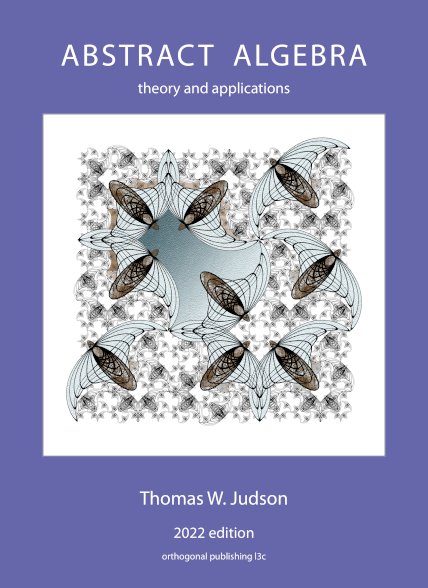Section 7.7 Sage
Since Sage began as software to support research in number theory, we can quickly and easily demonstrate the internal workings of the RSA algorithm. Recognize that, in practice, many other details such as encoding between letters and integers, or protecting one’s private key, are equally important for the security of communications. So RSA itself is just the theoretical foundation.
Subsection Constructing Keys
We will suppose that Alice wants to send a secret message to Bob, along with message verification (also known as a message with a digital signature). So we begin with the construction of key pairs (private and public) for both Alice and Bob. We first need two large primes for both individuals, and their product. In practice, values of
xxxxxxxxxxp_a = next_prime(10^10)q_a = next_prime(p_a)p_b = next_prime((3/2)*10^10)q_b = next_prime(p_b)n_a = p_a * q_an_b = p_b * q_bn_a, n_bComputationally, the value of the Euler
xxxxxxxxxxm_a = euler_phi(n_a)m_b = euler_phi(n_b)m_a, m_bNow we can create the encryption and decryption exponents. We choose the encryption exponent as a (small) number relatively prime to the value of
xxxxxxxxxxfactor(m_a)xxxxxxxxxxE_a = 5*23D_a = inverse_mod(E_a, m_a)D_axxxxxxxxxxfactor(m_b)xxxxxxxxxxE_b = 7*29D_b = inverse_mod(E_b, m_b)D_bAt this stage, each individual would publish their values of
xxxxxxxxxxprint("Alice's public key, n:", n_a, "E:", E_a)xxxxxxxxxxprint("Alice's private key, D:", D_a)xxxxxxxxxxprint("Bob's public key, n:", n_b, "E:", E_b)xxxxxxxxxxprint("Bob's private key, D:", D_b)xxxxxxxxxx# Practice area (not linked for Sage Cell use)Subsection Signing and Encoding a Message
Alice is going to construct a message as an English word with four letters. From these four letters we will construct a single number to represent the message in a form we can use in the RSA algorithm. The function
ord() will convert a single letter to its ASCII code value, a number between 0 and 127. If we use these numbers as “digits” mod 128, we can be sure that Alice’s four-letter word will encode to an integer less than xxxxxxxxxxword = 'Sage'digits = [ord(letter) for letter in word]digitsxxxxxxxxxxmessage = ZZ(digits, 128)messageFirst, Alice will sign her message to provide message verification. She uses her private key for this, since this is an act that only she should be able to perform.
xxxxxxxxxxsigned = power_mod(message, D_a, n_a)signedThen Alice encrypts her message so that only Bob can read it. To do this, she uses Bob’s public key. Notice how she does not have to even know Bob — for example, she could have obtained Bob’s public key off his web site or maybe Bob announced his public key in an advertisement in the New York Times.
xxxxxxxxxxencrypted = power_mod(signed, E_b, n_b)encryptedAlice’s communication is now ready to travel on any communications network, no matter how insecure the network may be, and no matter how many snoops may be monitoring the network.
xxxxxxxxxx# Practice area (not linked for Sage Cell use)Subsection Decoding and Verifying a Message
Now assume that the value of
encrypted has reached Bob. Realize that Bob may not know Alice, and realize that Bob does not even necessarily believe what he has received has genuinely originated from Alice. An adversary could be trying to confuse Bob by sending messages that claim to be from Alice. First, Bob must unwrap the encyption Alice has provided. This is an act only Bob, as the intended recipient, should be able to do. And he does it by using his private key, which only he knows, and which he has kept secure.xxxxxxxxxxdecrypted = power_mod(encrypted, D_b, n_b)decryptedRight now, this means very little to Bob. Anybody could have sent him an encoded message. However, this was a message Alice signed. Lets unwrap the message signing. Notice that this uses Alice’s public key. Bob does not need to know Alice — for example, he could obtain Alice’s key off her web site or maybe Alice announced her public key in an advertisement in the New York Times.
xxxxxxxxxxreceived = power_mod(decrypted, E_a, n_a)receivedBob needs to transform this integer representation back to a word with letters. The
chr() function converts ASCII code values to letters, and we use a list comprehension to do this repeatedly.xxxxxxxxxxdigits = received.digits(base=128)letters = [chr(ascii) for ascii in digits]lettersIf we would like a slightly more recognizable result, we can combine the letters into a string.
xxxxxxxxxx''.join(letters)Bob is pleased to obtain such an informative message from Alice. What would have happened if an imposter had sent a message ostensibly from Alice, or what if an adversary had intercepted Alice’s original message and replaced it with a tampered message? (The latter is known as a “man in the middle” attack.)
In either case, the rogue party would not be able to duplicate Alice’s first action — signing her message. If an adversary somehow signs the message, or tampers with it, the step where Bob unwraps the signing will lead to total garbage. (Try it!) Because Bob received a legitimate word, properly capitalized, he has confidence that the message he unsigned is the same as the message Alice signed. In practice, if Alice sent several hundred words as her message, the odds that it will unsign as cohrent text are astronomically small.
What have we demonstrated?
- Alice can send messages that only Bob can read.
- Bob can receive secret messages from anybody.
- Alice can sign messages, so that then Bob (or anybody else)knows they are genuinely from Alice.
Of course, without making new keys, you can reverse the roles of Alice and Bob. And if Carol makes a key pair, she can communicate with both Alice and Bob in the same fashion.
If you want to use RSA public-key encryption seriously, investigate the open source software GNU Privacy Guard, aka . Notice that it only makes sense to use encryption programs that allow you to look at the source code.
GPG, which is freely available at www.gnupg.org/8
www.gnupg.orgxxxxxxxxxx# Practice area (not linked for Sage Cell use)
